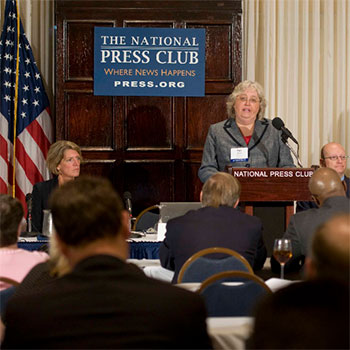Freight Logisticians Have Best Year Since Great Recession, However Capacity Issues Persist

The 26th Annual State of Logistics Report credits logisticians’ savvy management of their transportation networks for holding logistics costs to a historically low percentage of Gross Domestic Product.
According to the 26th Annual State of Logistics Report (SoL), the logistics and transportation industry chalked up its best year since the Great Recession, with U.S. business logistics costs rising 3.1 percent to $1.45 trillion last year.
Presented by the Council of Supply Chain Management Professionals (CSCMP) and Penske Logistics, the SoL reports that logistics costs were a scant 8.3 percent of GDP in 2014, a tenth of a percent lower than in each of the previous three years and less than half of what logistics costs were as a percentage of GDP in 1979, the last year of fully regulated surface freight transportation.
Freight transportation costs rose 3.6 percent last year due to stronger shipment volumes and inventory carrying charges that were up 2.1 percent, according to the report. But overall, it was a very solid year for logisticians, who were able to manage fluctuating volumes amid tight capacity due to infrastructure constraints and labor issues such as the West Coast dock slowdowns.
“In 2014, consumers began to drive the economy once again as consumer confidence measures soared,” says Rosalyn Wilson, author of the annual SoL report. “And it was freight transportation helping to drive that consumer spending in the most efficient manner possible.”
With freight transportation and tonnage volume still slightly below pre-recession levels, freight shipment volumes followed a predictable trend last year - starting the year at or below previous year levels, rising through the spring, flattening or even dropping during the summer, peaking during August and September, then falling close to the levels that the year started.
“Shipment volume rose in April, reaching the highest level since June 2011,” says Wilson. “Freight continued to gain momentum, although the performance of the economy overall during the period was very weak.”
In 2014, the trucking industry edged closer to 100 percent utilization. Predictably, the capacity constraints affected truck rates. In May 2014, freight payments were 11.2 percent higher than in May 2013 and 77.7 percent higher than at the end of the recession in 2009. “Rates held steady despite the tightening capacity,” says Wilson.
“Both the number of shipments and freight spend reached a crescendo in June, with shipment volume surpassing the November 2007 pre-recession levels.”
Turmoil returned in October in the form of a rising freight shipments, particularly imports. But the real story last fall was that freight was having a difficult time moving due to congestion in ports, especially in the ports of Los Angeles and Long Beach (LA/LB) where a long-standing labor dispute continued to simmer, Wilson said while releasing the report June 23 at the National Press Club.
Those ports handle more than 40 percent of all ocean imports, and an even higher percentage of consumer goods. By the end of October, there was more than a three-week delay in unloading ocean vessels at LA/LB.
By modes, here is how 2014 fared:
- Trucking the largest component of freight transportation costs, rose 3 percent last year as total trucking costs (intercity and local) surpassed $700 billion for the first time to $702 total. Intercity trucking rose 2.7 percent to $488 billion, and local delivery was up 3.7 percent to $216 billion;
- Rail transportation costs rose 6.5 percent to $80 billion. Class 1 freight revenue per ton-mile increased 0.1 percent from 3.961 cents to 4.054 cents, the report states. Overall rail traffic was up 4.5 percent - 3.9 percent for carloads and 5.2 percent for intermodal;
- Ocean transportation rose 8.9 percent, the second highest growth sector last year. The domestic costs for movement of freight in and out of the U.S. through its deep water ports was $31 billion - not including actual ocean shipping costs - and $9 billion for domestic lake and coastwise moves; and
- Air freight revenue slipped 1.2 percent to $28 billion ($12 billion international and $16 billion domestic). According to the SoL, this slip is due to “downshifting” by shippers to more expedited ground shipments and a 6 percent drop in international air shipments.
Looking ahead to this year, Wilson predicted rates should level out towards the end of this year. She said rate increases would be “modest to moderate” in 2016 depending on the level of economic activity, but said it is still a sellers’ market.
“Carriers will still have the ability to pass on their higher costs to shippers,” Wilson concluded.
Amazon’s Logistics App Underscores Capacity Concerns
It was less than a month ago when Amazon made its “free shipping” announcement. In short, the resulting chatter from the analyst community suggested that there was no way Amazon could make this work, without requiring a minimum order.
I was more bullish on the move. Not only do I see it as a logical way for Amazon to build order values, but also, I pointed out how the move would surely put Amazon’s already vaunted customer analytics and recommendation engine into a new orbit.
So Amazon’s latest announcement to beta test same day delivery using services like Flywheel and Uber, while novel, can hardly be seen as coming from out of the blue. It makes sense, and I don’t think there’s any posturing going on here. That said, the naysayers are already putting their spin on the shared experiences of drivers who have been tested:
“…A guy called me and told me what the deal was: pick up several packages and drop them off in the SJ area. When I got there they put the packages in my trunk in drop off order and handed me an optimized list of addresses. Completed the task in 2 hours and made $50. Not really worth the time or effort, turns out.”
Not so fast. Not really worth it to whom? Firstly, lets get our ducks in a row. Amazon is not just grappling with a simple cost issue. It’s hedging against a growing capacity issue that free shipping - at its scale - will exacerbate. And if I’m Amazon and foreshadowing explosive shipping growth, I don’t want my carriers licking their chops. Rather, at the very least, I want them stabbing each other with the sharp ends of their negotiating pencils. Or even better, I want them figuring this out for me.
“Capacity issues are on the horizon and I urge everyone to begin making contingency plans for the day when you cannot get a truck,” said Rosalyn Wilson, senior business analyst with Declan Inc. and the primary author of the annual State of Logistics report published by the Council of Supply Chain Management Professionals (CSCMP).
“The bottom line is that by every measurement, the trucking industry is compressing,” warned Wilson. “There are less trucks, less drivers, and fewer [trucking] companies. Carriers have ‘leaned’ their fleets and will continue to do so. As a result, paying higher [trucking] rates going forward won’t be as much of a worry for shippers as not being able to find a truck to move their freight.”
Am I simply suggesting that all the talk of free delivery and now, taxi-based delivery service, is Amazon’s way of putting the major carriers on notice? Let’s put it this way: I don’t think that skyrocketing delivery costs (up 32 percent in recent years) and Amazon’s latest media blitz are coincidental. Amazon’s shipping costs, as a percent of sales, are up nearly 2% in the last 5 years and that’s not a sustainable trend.
We can count on Amazon to not lollygag this problem with its eyes wide-shut. There is a real and growing capacity issue that threatens to remove some of the shine from online commerce. Amazon is not going to allow itself to become its own worse enemy, meaning, it will not contribute to a situation that could re-invigorate brick and mortar-based cash and carry. Its experiments with new modes of shipping - to increase capacity - is a high stakes necessity.
Author: Paul Martyn, for Forbes
Article Topics
CSCMP News & Resources
60 Seconds with Robert Martichenko of American Logistics Aid Network Sustainability Efforts Continue to Ramp Up, Research Finds Today’s modern shipper-3PL relationships focus on collaborative growth and improvement BlueGrace executive assesses various market trends and themes at CSCMP EDGE CSCMP EGDE panel examines the impact of supply chain volatility on costs and operations Top Target supply chain executive McCarthy provides an inside look at the company’s supply chain and logistics operations 2023 State of Logistics Report: Great logistics reset More CSCMPLatest in Transportation
Ask an Expert: How Shippers Can Prep for Hurricane Season UPS Struggles in First Quarter With Steep Earnings Decline FedEx Announces Plans to Shut Down Four Facilities The Two Most Important Factors in Last-Mile Delivery Most Companies Unprepared For Supply Chain Emergency Baltimore Bridge Collapse: Impact on Freight Navigating Amazon Logistics’ Growth Shakes Up Shipping Industry in 2023 More Transportation














